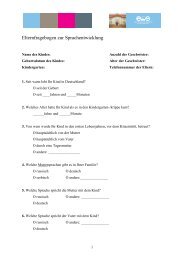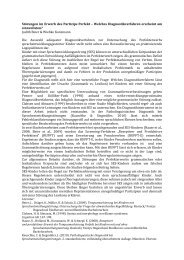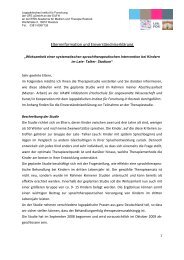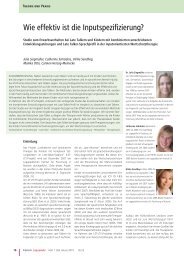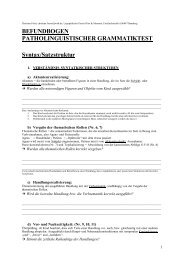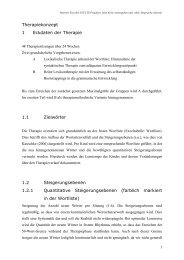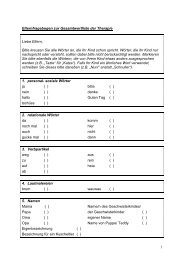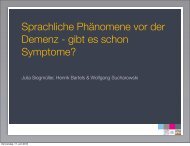mutual exclusivity constraint - Opus - KOBV
mutual exclusivity constraint - Opus - KOBV
mutual exclusivity constraint - Opus - KOBV
Sie wollen auch ein ePaper? Erhöhen Sie die Reichweite Ihrer Titel.
YUMPU macht aus Druck-PDFs automatisch weboptimierte ePaper, die Google liebt.
Fabbro, F., Alberti, B., Gagliardi, C., & Borgatti, R. 2002. Differences in native and foreign language<br />
repetition tasks between subjects with William´s and Down´s syndrome. Journal of<br />
Neurolinguistics, 15: 1-10.<br />
Fenson, L., Dale, P. S., Reznick, J. S., Thal, D., Bates, E., Hartung, J. P., Pethick, S., & Reilly, J. S.<br />
1993. MacArthur Communicative Development Inventories: User´s guide and technichal<br />
manual. San Diego: Singular Publishing Group.<br />
Fletcher, P. & Ingham, R. 1995. Grammatical impairment. In Fletcher, P. & MacWhinney, B. (Eds.),<br />
The handbook of child language. Oxford, Blackwell: 603-623.<br />
Fodor, J. A. 1983. The modularity of mind. Cambridge: Bradford Book.<br />
Fox, A. V. & Dodd, B. J. 1999. Der Erwerb des phonologischen Systems in der deutschen Sprache.<br />
Sprache-Stimme-Gehör, 23: 183-191.<br />
Frangiskakis, J. M., Ewart, A., Morris, C. A., Mervis, C., Bertrand, J., Robinson, B. F., Klein, B. P.,<br />
Ensing, G. J., Everett, L. A., & Green, E. D. 1996. LIM-Kinase1 hemizygosity implicated in<br />
impaired visuospatial constructive cognition. Cell, 86: 59-69.<br />
Franklin, I., McAllister, C., & Whitton, J. 1994. SCHUBI Fotokarten. Schaffhausen: Winslow Press,<br />
SCHUBI Lehrmittel AG.<br />
Gerken, L. A. & Shady, M. E. 1996. The picture selection task. In McDaniel, D., MCKee, C., & Smith<br />
Cairns, H. Cambridge, MIT Press: 125-145.<br />
Golinkoff, R., Mervis, C., & Hirsh-Pasek, K. 1994. Early object labels: The case for a developmental<br />
lexical principles framework. Journal of Child Language, 21: 125-155.<br />
Gosch, A. & Pankau, R. 1994. Social-emotional and behavioral adjustment in children with Williams-<br />
Beuren-Syndrome. American Journal of Medical Genetics, 53: 335-339.<br />
Gosch, A., Städing, G., & Pankau, R. 1994. Linguistic abilities in children with Williams-Beuren-<br />
Syndrome. American Journal of Medical Genetics, 52: 291-296.<br />
Grant, J., Karmiloff-Smith, A., Berthoud, I., & Christophe, A. 1996. Is the language of people with<br />
Williams syndrome mere mimicry? Phonological short-term memory in a foreign language.<br />
CPC, 15: 615-628.<br />
Grant, J., Karmiloff-Smith, A., Gathercole, S. A., Paterson, S., Howlin, P., Davies, M., & Udwin, O.<br />
1997. Phonological short-term memory and its relationship to language in Williams syndrome.<br />
Cognitive Neuropsychiatry, 2: 81-99.<br />
Grant, J., Valian, V., & Karmiloff-Smith, A. 2002. A study of relative clauses in Williams syndrome.<br />
Journal of Child Language, 29: 403-416.<br />
Grimm, H. & Doil, S. 2000. ELFRA 2 - Elternfragebogen für zweijährige Kinder. Göttingen: Hogrefe.<br />
Grzeschik, K.-H. 2004. Genotype in Williams syndrome. In Bartke, S. & Siegmüller, J. Amsterdam,<br />
Benjamins: 39-59.<br />
Günther, K. B. 1988. Probleme der Diagnostik lexikalisch-semantischer Entwicklungsstörungen am<br />
Beispiel des aktiven Wortschatztestes für drei- bis sechsjährige Kinder (AWST 3-6). In<br />
Günther, K. B. (Ed.), 117-166. Heidelberg, Edition Schindele:.<br />
Hagerman, R. J., Schreiner, R. A., Kemper, M. B., Wittenberger, M. D., Zahn, B., & Habicht, K. 1989.<br />
Longitudinal IQ changes in fragile X males. American Journal of Medical Genetics, 33: 513-<br />
518.<br />
Haryu, E. & Imai, M. 1999. Controlling the application of the <strong>mutual</strong> <strong>exclusivity</strong> assumption in the<br />
acquisition of lexical hierarchies. Japanese Psychological Research, 41: 21-34.<br />
Hernandez Jarvis, L., Merriman, W. E., Barnett, M., Hanba, J., & Van Haitsma, K. S. 2004. Input that<br />
contradicts young children´s strategy for mapping novel words affects their phonological and<br />
semantic interpretation of other novel words. Journal of Speech, Language, and Hearing<br />
Research, 47: 392-406.<br />
Hirsh-Pasek, K. 2002. How to become a word learner. Potsdam: Workshop an der Universität<br />
Potsdam, 4. Juli 2002.<br />
Hirsh-Pasek, K., Michnick Golinkoff, R., & Hollich, G. 2000a. An emergentist coalition model for<br />
word learning: mapping words to objects is a product of the integration of multiple cues. In<br />
Michnick Golinkoff, R., Hirsh-Pasek, K., Bloom, L., Smith, L. B., Woodward, A. L., Akhtar,<br />
N., Tomasello, M., & Hollich, G. (Eds.), Becoming a word learner. A debate on lexical<br />
acquisition. Oxford, New York, Oxford University Press: 136-164.<br />
Hirsh-Pasek, K. & Golinkoff, R. 2000b. The whole is greater than the sum of the parts or why the<br />
Emergentist Coalition Model works (Counterpoint commentary). In Michnick Golinkoff, R.,<br />
Hirsh-Pasek, K., Bloom, L., Smith, L. B., Woodward, A. L., Akhtar, N., Tomasello, M., &<br />
Hollich, G. (Eds.), Becoming a word learner. A debate on lexical acquisition. Oxford, Oxford<br />
University Press: 186-195.<br />
153







